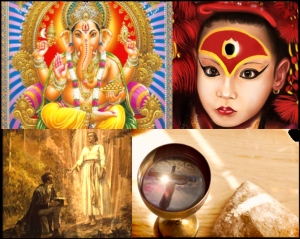 But I’m on the outside, and I’m looking in. – Staind
But I’m on the outside, and I’m looking in. – Staind
There are many ways to judge intelligence: book learning, street smarts, wisdom gained through trial and error, compassion deepened by struggles with tragedy and loss.
The longer I live, there is one measurement that becomes more precious: the ability to stand outside ourselves and see how we affect the world around us. Why? A number of reasons. Steeped in familial and cultural biases, we find it hard to walk in the shoes of another. Our own ego needs for safety, control, and affection often dominate our motives.
Can we stand on the outside and look in with a fresh perspective? Consider how this applies to religious beliefs and practices.
In a recent issue of National Geographic is a story about kumaris in the Nepalese Hindu communities surrounding Katmandu. These are pre-pubescent girls believed to be incarnations of Chandi, a Hindu goddess. Once chosen, they live a rarified life, dressed in red garments, adorned with special cosmetics. Their feet must never touch the ground. People from the community come to worship them and have prayer requests granted.
Families campaign to present their children for this honor – like a spiritual beauty pageant – even though it presents financial hardship. When the girls have their first menstruation, they lose their throne, a change so jarring that there are counseling programs to help them debrief. The demotion from goddess to mere mortal is traumatic.
To me, this seems so bizarre. Its objectifying of children appears harmful. I understand the basic theology – that we must learn to see divinity in all people – but does it have to take such an extreme form of ritualistic practice?
However, I’m outside looking in. I must remember this. I feel the same way about other religious traditions: Joseph Smith’s “discovery” of golden plates in Palmyra, elephantine statues of Ganesha staring down from altars, the reverence of Koranic words as if they are written in fire.
Let me share something that has been extremely liberating: to stand outside the Christian tradition and see the strangeness of its traditions and cultural blinders. I think of a virgin birth; miracles like walking on water; a sacrament that says “Take and eat, this is my body,” “Take and drink, this is my blood;” the anointing of leaders who are Zionist, homophobic, and misogynistic; any martyr’s insistence that there is only one way to “heaven.”
During my final years as a pastor, I worked around these oddities, emphasizing the underlying message of grace. I tried to communicate that all icons, symbols, and rituals are simply pointers to other realities. Hopefully, no matter what paradigm we live within, these realities are peace, unity, and reconciliation.
Isn’t this healthy for all of us – to stand on the outside and look in?